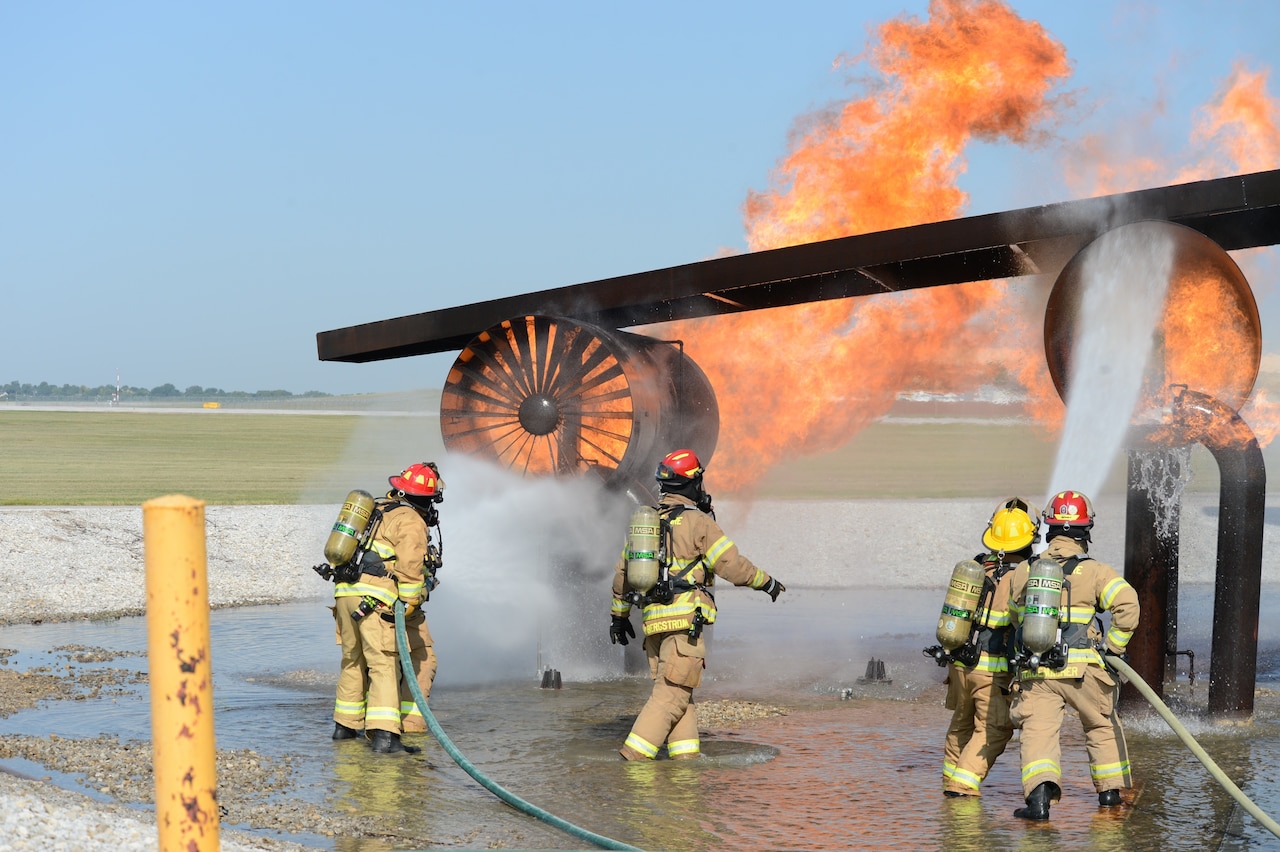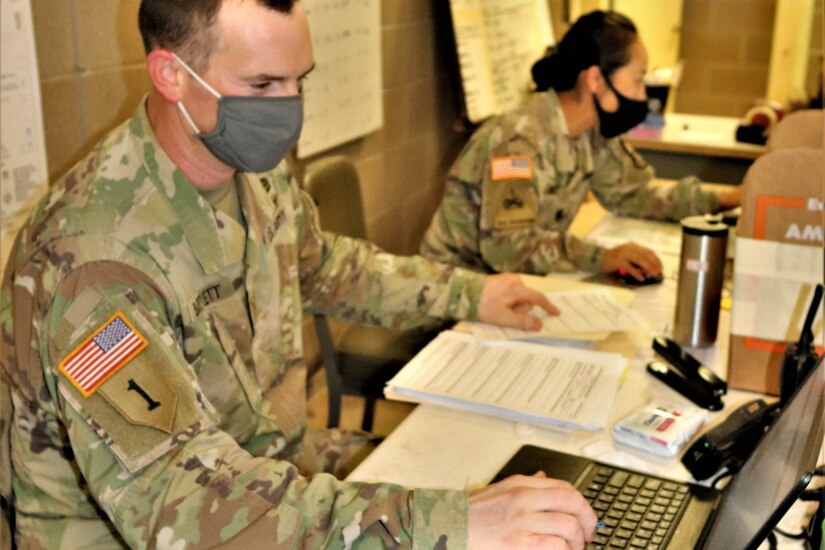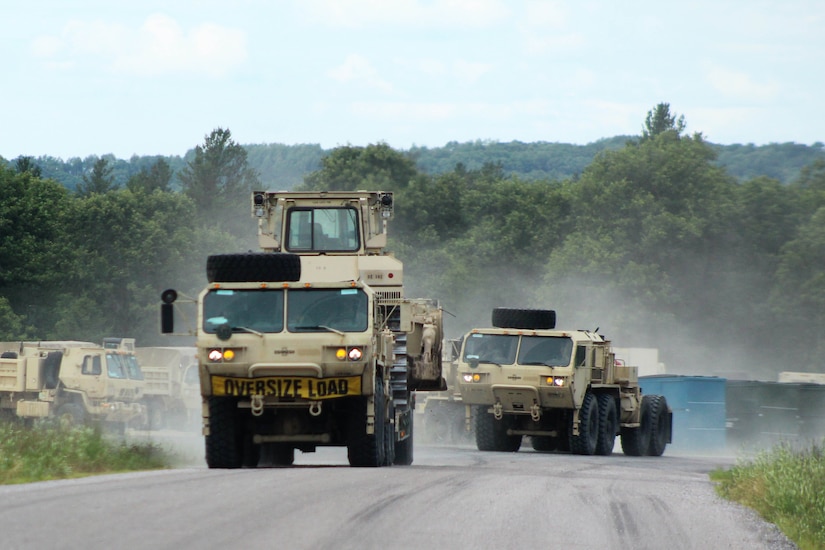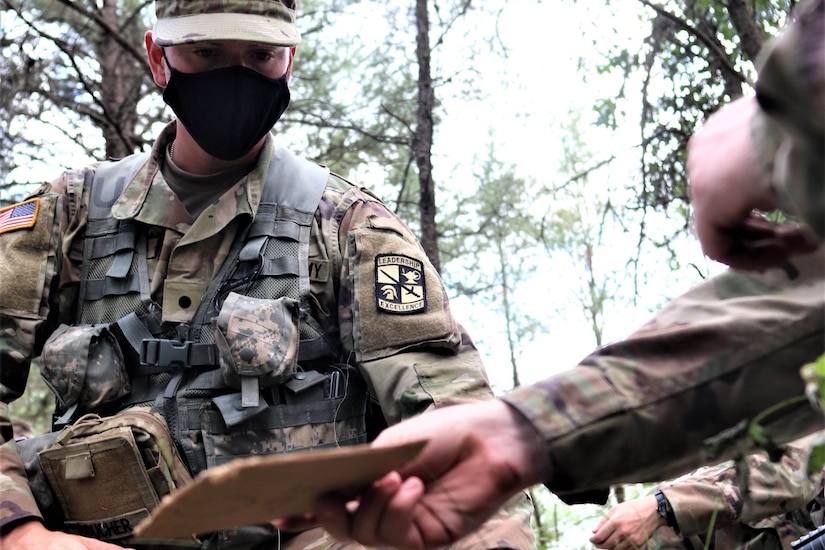A soldier participates in engineer reconnaissance training at Schofield Barracks, Hawaii, Sept. 22, 2020.
Providing up-to-date information, news and original content on American Military issues.
A soldier participates in engineer reconnaissance training at Schofield Barracks, Hawaii, Sept. 22, 2020.
Nevada National Guard soldiers help support a community-based collection site at Mandalay Bay in Las Vegas, Nev., Sept. 21, 2020. Army Maj. Gen. Ondra Berry, adjutant general for the state of Nevada, came by to see the operation.
Air Force 1st Lt. Erica Chambers, assigned to the 86th Maintenance Squadron, helps the Red Cross assemble care packages at Ramstein Air Base, Sept. 22, 2020. The Red Cross partners with Operation Gratitude to help prepare and distribute care packages for first responders in the community.
Navy Petty Officer 2nd Class Alex Heineman salutes Cmdr. Dan Reiher after receiving an accomplishment medal during an all-hands call at Naval Air Station Key West, Fla., Sept. 24, 2020
Airmen operate radar and navigation controls inside a B-52H Stratofortress during a task force mission over the eastern Mediterranean Sea, Sept. 16, 2020.
Sept. 24, 2020 | BY AIR FORCE TECH. SGT. R. DENISE MOMMENS
For the better part of six months, the COVID-19 pandemic has caused numerous unforeseen impacts across the nation and locally in Nebraska.
One of those impacts that had the potential to cause a significant effect on the Nebraska National Guard air base has been the closing down of formal firefighting schools. This, in turn, made it difficult for the Nebraska Air Guard Base Fire Department to fill openings as members of the team either deployed, retired or transferred to new jobs or departments.
That's when members of the fire department decided to try a novel approach to solving its problem. Instead of waiting for the formal firefighting schools to reopen, they would train their own firefighters.

According to Bruce Craig, Nebraska Air National Guard Fire Department assistant chief, by training newly-hired firefighters locally in Lincoln and at Offutt Air Force Base, they were able to meet the critical shortage of trained and qualified firefighters, while also providing the crucial training they need to respond to both aviation emergencies and the multitude of other duties they're responsible for.
"The amount of people out on the streets to be able to do this job with prerequisites, [those] numbers were way down," Craig said, prior to a 3-day progressive training at Offutt Air Force Base, Aug. 24-26, 2020. "So we opened it up with no prerequisites."
Typically, Craig said, there are standard prerequisites that a potential Nebraska Air Guard firefighter must meet before he or she is hired. For example, selected individuals normally have already attended firefighter schools, or they are sent to a formal school shortly after being hired. COVID-19, however, forced schools to limit the number of students who could attend or they simply cancelled courses altogether.
"With schools being closed, we are having to teach them to be a firefighter," Craig said.
The training covers skills like vehicle extrication, putting on protective gear, correct ladder techniques, licensing on various vehicles and how to successfully rescue people trapped in a building or an aircraft fire.
"Our fires are usually hotter for the most part, because a fuel fire is hotter than regular combustible material fire," Craig said, adding that base firefighters must know how to deal with hazardous materials, and provide medical care to people injured in such fires.
Probably the most important skill, though, is the ability to know how to quickly and accurately respond to an aircraft fire, Craig said.
"We respond out onto an airfield. We don't have hydrants out there, so our distance for hydrants are a lot larger," he said. "Most of our trucks carry large quantities of water, [along with special fire retardant material], because we fight fuel fires."

According to the new firefighters, the training has been a great way to learn under realistic conditions.
"Everything that has to do with the aircraft, engines, the fuel, makes it a bigger challenge. Which makes it more exciting," said Rob Rector, one of the five new firefighters. "There is that element of aircraft and being on base that makes it a little different."
"We have different instructors every day," said Adam Braun, new-hire firefighter. "Our overall task here is: you make sure the airplanes on the runways coming in, if they have any emergencies, we are the first responders."
Craig said there was a second advantage to conducting the training themselves. While teaching the new firefighters, the more experienced team members had the opportunity to re-learn some skills.
"It gave us a huge opportunity to get people that were already here back to the basics by allowing them to instruct it," Craig said. "They really had to get back into it, get back to the basics to teach the basics."
"While they're teaching, they are learning it all over again," he added.
(Air Force Tech. Sgt. R Denise Mommens is assigned to the 155th Air Refueling Wing).
Sept. 24, 2020 | BY Scott Sturkol, Army
When Army Col. Michael D. Poss took command of the Fort McCoy (Wisconsin) Garrison, June 10, 2020, he was likely the first to assume that role while the country was responding to a global pandemic.
"I was experiencing the pandemic like everyone else this spring," Poss said, who was the chief of staff for the 451st Expeditionary Sustainment Command at the Army Reserve Center in Wichita, Kansas, prior to coming to Fort McCoy. "We were undergoing probably the same thing that everyone else was dealing with. We were trying to figure out how to operate in this new environment."

"I was coming in every day, working 12 hours with a small team, and we were trying to plan out the training requirements that were coming up," Poss said. "In addition, I was simultaneously planning my transition to Fort McCoy that was certainly unique with some challenges from COVID."
The COVID-19 pandemic had been ongoing for more than two months when Poss took the reins of the Garrison. Many services and facilities were closed at that time, and training was at a standstill. However, he said, the Fort McCoy team did a great job bringing many important services and capabilities back online.
"I think it helped us as an Army, collectively, to learn that we can operate in an environment such as this," Poss said. "We have been trained in the Army that sometimes you have to operate in less-than-perfect conditions. Sometimes you have to operate at night. Sometimes you have to operate with degraded communications or cyber capability. Sometimes you have to operate in a chemical environment. So this was a new situation where we had to learn how to operate in the COVID environment. When I arrived at Fort McCoy, one of the first questions I started asking 'was what sort of services here on Fort McCoy can we look to open up in a safe and effective manner?'"
One of the first places to reopen on post was Pine View Campground, which resumed operations May 22.
"The installation first opened the campground for recreation," Poss said. "It's a place that is outdoors, so you can socially distance fairly easily out there."
Then Poss said the installation needed to reopen the Child Development Center, or CDC, and the School Age Center/Youth Center because those facilities directly support military and civilian workforce members on post.
"We wanted to look at opening up the CDC, and I was there on opening day to see how it would go. Prior to that, we had visited the center quite extensively and talked with the staff... It was great to see the employees bringing the children. It was a new environment, but we adapted with new procedures. The children seemed to be excited. The parents seemed to be excited. That did help us in our goal of starting to bring back employees to the workplace in a safe and effective manner."
As services began to reopen, strong COVID-19 protective measures had to be installed. The post already had policy letter 37 in place, which enforced sanitation and hygiene procedures for the Fort McCoy community and workforce. Next, the Fort McCoy team worked to create policy letter 38.

"Policy 38 spells out how we will operate and train in a COVID-19 environment," Poss said.
With the policies in place, chapel services operated by the religious support office resumed, and Rumpel Fitness Center reopened as well.
"I asked the chaplain if there was a way we could build spiritual resilience by opening up the chapel services," Poss said. "Then he came up with a plan, we talked about it, and soon after, those services were resumed, and a week later Bishop Richard Spencer of the Archdioceses of Military Services visited us."
"The next thing we considered was opening Rumpel Fitness Center in order to build physical resilience," Poss said. "The staff there did a great job and effort to come up with a very detailed plan to open up, and it's been highly successful. We have received a lot of good feedback from people assigned here and those who are visiting that the setup we have with all the safety protocols is working. People are excited about being able to use the facility."
The policy letters also addressed the return of training activities at Fort McCoy, which resumed July 7 after stopping in early April.
"We had to look at how we can train in a very safe and effective manner in order to build readiness," Poss said. "That's important because, as the Army, that is what we're all about. It's about conducting training and being ready."
"One of the first examples of training returning to pre-COVID levels was the mobilization of a large medical unit here — the 228th Combat Support Hospital," he said. "We have great facilities and subject matter experts. So, we welcomed the opportunity to do that in a safe and effective manner, and it was successful. The unit just recently deployed to a theater, and they were appreciative of the training they received at Fort McCoy."
"It was a great test for our mobilization force training partners on Fort McCoy, and they did a terrific job," Poss continued. "This included the 88th Readiness Division, 181st Multi-Functional Training Brigade, Regional Training Site-Medical and the mission-support forces here. And we also didn't stop there. We recently had the commander of Army ROTC stop by Fort McCoy for a visit. ROTC had their annual six-week summer camp canceled, but they still needed to conduct some training for their cadets. They came up with a two-week condensed version of training, and the 3rd ROTC Brigade held it at Fort McCoy. That was also very successful."
Fort McCoy started receiving requests from other units to use ranges for qualification purposes and other collective training. In addition, we recently hosted the U.S. Army Reserve Command Best Warrior Competition.
"We had requests from Marines this summer to perform field training," Poss said. "We had a large request from the Navy to help them out with the quarantine of their recruits for the first two weeks of basic training. All of it has been supported by Team McCoy with great success."
"Also, the Army Reserve asked us to support training," he continued. "Normally we would be hosting several large exercises for the Army Reserve. Unfortunately those events got canceled in spring and early summer because of COVID.
But the Army Reserve still wanted to do something in order to train and build readiness. That's how they came up with Operation Ready Warrior. We were the first installation to host an iteration. More than 1,000 soldiers were trained here so they could build readiness."
The response to the pandemic caused many changes at Fort McCoy, but he said the Fort McCoy team or "Team McCoy" — which includes Garrison and tenant organizations on post — really stepped up to be successful in operating in a pandemic environment.
"Every morning I remind myself to be a humble servant as a leader and to continue to balance family and work commitments," Poss said. "When I go about my day, there are so many opportunities where I thank people for what they are doing. I am so proud of this workforce here at Fort McCoy."
Poss said he remembers having mobilized through Fort McCoy with his unit.
"I remember mobilizing here for a deployment to Iraq as a captain," Poss said. "I remember the fantastic, dedicated people here at Fort McCoy. We were going to a tough area in Iraq on a difficult assignment, but the amount of training we received here set us up for success. So, in addition to the training and the resources, it's the dedication of the people."
"From day one, after I arrived and assumed garrison command, I pursued a very aggressive circulation plan where I would get out every day and meet as many people as possible" he said. "I'm the first one to admit that I am not an expert in their areas, but I want to learn more. Their expertise and dedication make Team McCoy successful."

Poss has also spent significant time holding community engagements with the mayors of Tomah and Sparta — both cities close to the installation — to build and strengthen those inter-community relationships.
"I have established a tremendous working relationship with them as well as with many others, including local government representatives, city police chiefs, chamber of commerce executives, business owners, city council members, community members and school leaders to include superintendents, principals, school board members and teachers," he said.
The Garrison commander added he is looking forward to continued success in the future.
"Fort McCoy is always looking at lessons learned and ways to improve," Poss said. "This is a learning organization and a thinking organization. And it's been great. We have such a remarkable team in place. I just continue to empower them, show my appreciation, and I learn from them every day. We are continuing to demonstrate that we value diversity and inclusion for strong Army teams."
Located in the heart of the upper Midwest, Fort McCoy is the only U.S. Army installation in Wisconsin.
The installation has provided support and facilities for the field and classroom training of more than 100,000 military personnel from all services each year since 1984.
(Scott Sturkol is assigned to Fort McCoy).